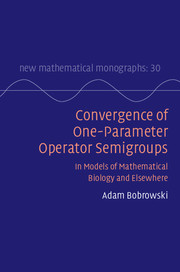Preface
Published online by Cambridge University Press: 05 July 2016
Summary
Now lift up your eyes, and look from the place where you are, northward and southward and eastward and westward; for all the land that you see I will give to you and to your seed forever.
(Gen. 13:14b–15. Holy Bible. Recovery Version. © 2003 Living Stream Ministry, Anaheim, California.)The question of convergence and the related Trotter–Kato–Neveu–Sova–Kurtz Theorem lie in the center of the theory of one-parameter semigroups of operators. In fact, many key results, including the fundamental Hille–Yosida Theorem, are proved by approximating a semigroup involved by a family of semigroups that are easier to handle. On the other hand, themost elegant proof of the Trotter–Kato–Neveu–Sova–Kurtz Theorem is obtained by applying the Hille– Yosida Theorem to a certain, coordinate-wise acting operator in the space of convergent sequences [163, 211, 229]. Hence, all of the basic books devoted to the theory, except, of course, of the classics [115] and [180] published before the Trotter–Kato–Neveu–Sova–Kurtz Theorem was known, treat the subject at least roughly (see, e.g., [9, 101, 128, 163, 284, 334, 353]). Other books, like [132], take advantage of the theory and show its beautiful and far-reaching applications.
This book aims to present the classic theory of convergence of semigroups and also to discuss its applicability to models of mathematical biology and other branches of mathematics. At the same time, it is an attempt at expressing my long fascination with phenomena accompanying such convergence, and my continuous amazement at the variety of examples, especially of the stochastic type, found in the literature.
The main difficulty in applying the theory to the models mentioned here is that the Trotter–Kato–Neveu–Sova–Kurtz-type theorems characterize convergence that is almost uniform in time t ∈ [0,∞), whereas in the models one often encounters a situation in which convergence is not uniform in the neighborhood of t = 0. Therefore, this book splits naturally into two parts. In the first part, I discuss the models in which the classical theory applies. In the second part, I present methods developed for treating convergence that is not uniform near t = 0, such as singular perturbations. Therefore, in particular, the book is an outgrowth of TosioKato's project [199] to incorporate singular perturbations in the theory of convergence of semigroups of operators.
- Type
- Chapter
- Information
- Convergence of One-Parameter Operator SemigroupsIn Models of Mathematical Biology and Elsewhere, pp. xi - xivPublisher: Cambridge University PressPrint publication year: 2016

